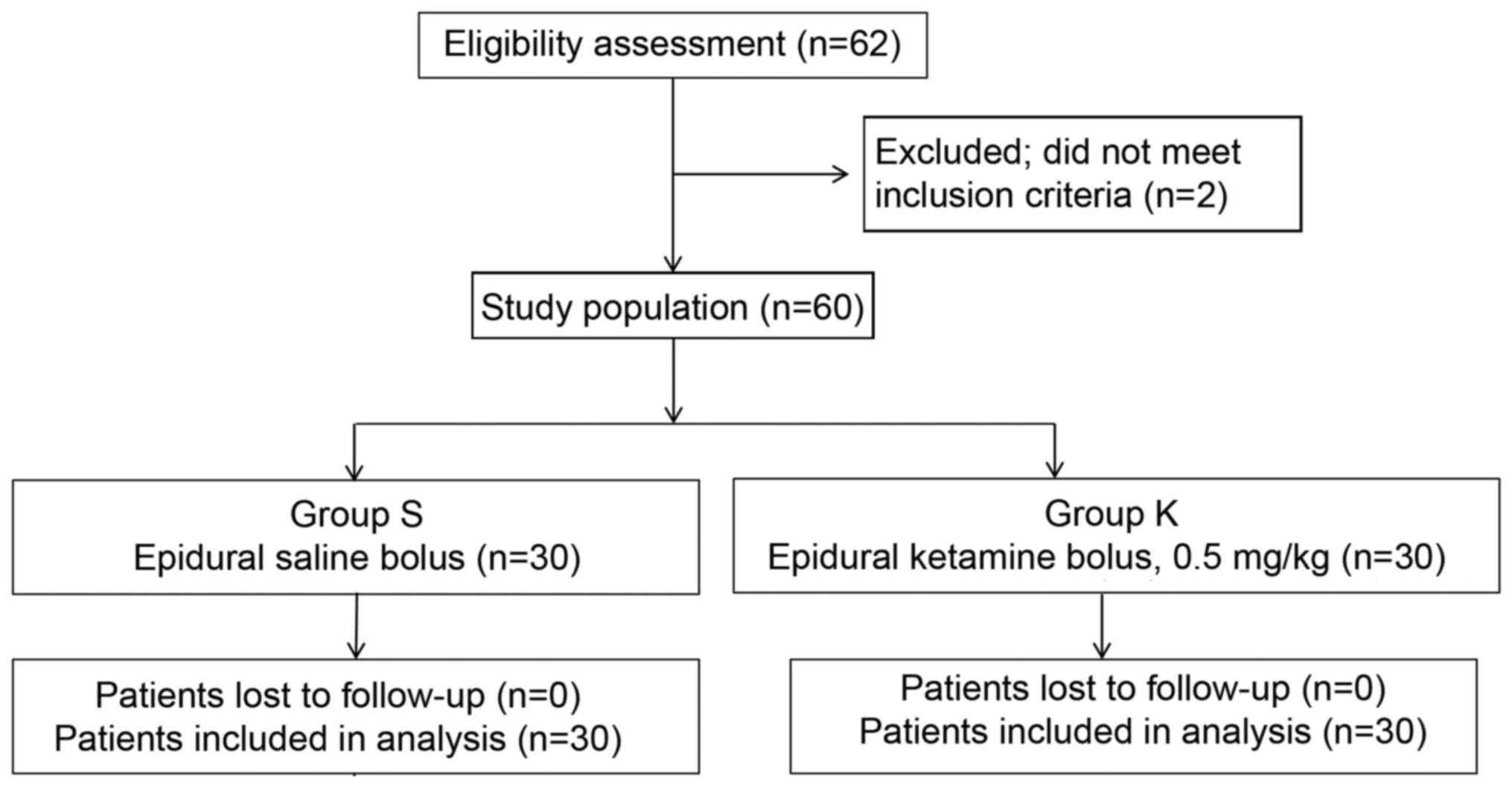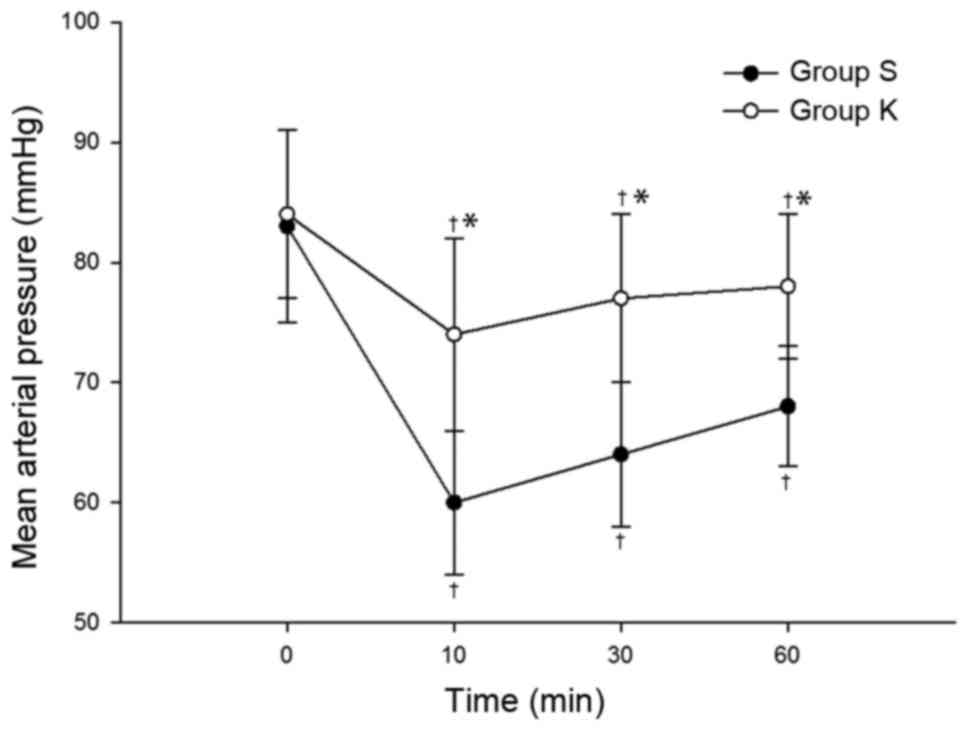|
1
|
Salman C, Kayacan N, Ertuğrul F, Bıgat Z
and Karslı B: Combined spinal-epidural anesthesia with epidural
volume extension causes a higher level of block than single-shot
spinal anesthesia. Braz J Anesthesiol. 63:267–272. 2013. View Article : Google Scholar : PubMed/NCBI
|
|
2
|
Crossley AWA, Mcvey FK and Cartwright DP:
Perioperative shivering. Lancet. 338:10261991. View Article : Google Scholar : PubMed/NCBI
|
|
3
|
Shakya S, Chaturvedi A and Sah BP:
Prophylactic low dose ketamine and ondansetron for prevention of
shivering during spinal anaesthesia. J Anaesthesiol Clin Pharmacol.
26:465–469. 2010.PubMed/NCBI
|
|
4
|
Sessler DI: Temperature monitoring and
perioperative thermoregulation. Anesthesiology. 109:318–338. 2008.
View Article : Google Scholar : PubMed/NCBI
|
|
5
|
Badawy AA and Mokhtar AM: The role of
ondansetron in prevention of post-spinal shivering (PSS) in
obstetric patients: A double-blind randomized controlled trial.
Egypt J Anaesth. 33:29–33. 2017. View Article : Google Scholar
|
|
6
|
Kose EA, Dal D, Akinci SB, Saricaoglu F
and Aypar U: The efficacy of ketamine for the treatment of
postoperative shivering. Anesth Analg. 106:120–122. 2008.
View Article : Google Scholar : PubMed/NCBI
|
|
7
|
Zahra FA, Abudallah HM, Shabana RI,
Abdulmageed WM, Abdulrazik SI and Nassar AM: Intramuscular ketamine
for prevention of postanesthesia shivering in children. Saudi Med
J. 29:1255–1259. 2008.PubMed/NCBI
|
|
8
|
Crowley LJ and Buggy DJ: Shivering and
neuraxial anesthesia. Reg Anesth Pain Med. 33:241–252. 2008.
View Article : Google Scholar : PubMed/NCBI
|
|
9
|
Kranke P, Eberhart LH, Roewer N and Tramèr
MR: Pharmacological treatment of postoperative shivering: A
quantitative systematic review of randomized controlled trials.
Anesth Analg. 94:453–460. 2002. View Article : Google Scholar : PubMed/NCBI
|
|
10
|
de Figueiredo Locks G: Incidence of
shivering after cesarean section under spinal anesthesia with or
without intrathecal sufentanil: A randomized study. Rev Bras
Anestesiol. 62:676–684. 2012. View Article : Google Scholar : PubMed/NCBI
|
|
11
|
Tsai YC and Chu KS: A comparison of
tramadol, amitriptyline, and meperidine for postepidural anesthetic
shivering in parturients. Anesth Analg. 93:1288–1292. 2001.
View Article : Google Scholar : PubMed/NCBI
|
|
12
|
Dal D, Kose A, Honca M, Akinci SB, Basgul
E and Aypar U: Efficacy of prophylactic ketamine in preventing
postoperative shivering. Br J Anaesth. 95:189–192. 2005. View Article : Google Scholar : PubMed/NCBI
|
|
13
|
Kose EA, Honca M, Dal D, Akinci SB and
Aypar U: Prophylactic ketamine to prevent shivering in parturients
undergoing Cesarean delivery during spinal anesthesia. J Clin
Anesth. 25:275–280. 2013. View Article : Google Scholar : PubMed/NCBI
|
|
14
|
Crossley AWA and Mahajan RP: The intensity
of postoperative shivering is unrelated to axillary temperature.
Anaesthesia. 49:205–207. 1994. View Article : Google Scholar : PubMed/NCBI
|
|
15
|
Wang W, Li Y, Sun A, Yu H, Dong J and Xu
H: Determination of the median effective dose (ED50) of bupivacaine
and ropivacaine unilateral spinal anesthesia: Prospective, double
blinded, randomized dose-response trial. Anaesthesist. 66:936–943.
2017. View Article : Google Scholar : PubMed/NCBI
|
|
16
|
Finster M and Wood M: The Apgar score has
survived the test of time. Anesthesiology. 102:855–857. 2005.
View Article : Google Scholar : PubMed/NCBI
|
|
17
|
Wilson E, David A, MacKenzie N and Grant
IS: Sedation during spinal anaesthesia: Comparison of propofol and
midazolam. Br J Anaesth. 64:48–52. 1990. View Article : Google Scholar : PubMed/NCBI
|
|
18
|
Roy JD, Girard M and Drolet P: Intrathecal
meperidine decreases shivering during cesarean delivery under
spinal anesthesia. Anesth Analg. 98:230–234. 2004. View Article : Google Scholar : PubMed/NCBI
|
|
19
|
Sessler DI: Complications and treatment of
mild hypothermia. Anesthesiology. 95:531–543. 2001. View Article : Google Scholar : PubMed/NCBI
|
|
20
|
Rajek A, Greif R and Sessler DI: Effects
of epidural anesthesia on thermal sensation. Reg Anesth Pain Med.
26:527–531. 2001. View Article : Google Scholar : PubMed/NCBI
|
|
21
|
Giuliano KK and Hendricks J: Inadvertent
perioperative hypothermia: Current nursing knowledge. AORN J.
105:453–463. 2017. View Article : Google Scholar : PubMed/NCBI
|
|
22
|
Zhou P, Ge S, Wang Y, Xiong W, Wang T and
Xue Z: Novamin infusion: A new method to cure postoperative
shivering with hypothermia. J Surg Res. 188:69–76. 2014. View Article : Google Scholar : PubMed/NCBI
|
|
23
|
Webb PJ, James FM III and Wheeler AS:
Shivering during epidural analgesia in women in labor.
Anesthesiology. 55:706–707. 1981. View Article : Google Scholar : PubMed/NCBI
|
|
24
|
Kranke P, Eberhart LH, Roewer N and Tramèr
MR: Single-dose parenteral pharmacological interventions for the
prevention of postoperative shivering: A quantitative systematic
review of randomized controlled trials. Anesth Analg. 99:718–727.
2004. View Article : Google Scholar : PubMed/NCBI
|
|
25
|
Horn EP, Sessler DI, Standl T, Schroeder
F, Bartz HJ, Beyer JC and Esch Schulte am J: Non-thermoregulatory
shivering in patients recovering from isoflurane or desflurane
anesthesia. Anesthesiology. 89:878–886. 1998. View Article : Google Scholar : PubMed/NCBI
|
|
26
|
Kim G, Kim MH, Lee SM, Choi SJ, Shin YH
and Jeong HJ: Effect of pre-warmed intravenous fluids on
perioperative hypothermia and shivering after ambulatory surgery
under monitored anesthesia care. J Anesth. 28:880–885. 2014.
View Article : Google Scholar : PubMed/NCBI
|
|
27
|
Golembiewski J: Pharmacological management
of perioperative shivering. J Perianesth Nurs. 30:357–359. 2015.
View Article : Google Scholar : PubMed/NCBI
|
|
28
|
Gozdemir M, Usta B, Demircioglu RI, Muslu
B, Sert H and Karatas OF: Magnesium sulfate infusion prevents
shivering during transurethral prostatectomy with spinal
anesthesia: A randomized, double-blinded, controlled study. J Clin
Anesth. 22:184–189. 2010. View Article : Google Scholar : PubMed/NCBI
|
|
29
|
Shukla U, Malhotra K and Prabhakar T: A
comparative study of the effect of clonidine and tramadol on
post-spinal anaesthesia shivering. Indian J Anaesth. 55:242–246.
2011. View Article : Google Scholar : PubMed/NCBI
|
|
30
|
Pawar MS, Suri N, Kaul N, Lad S and Khan
RM: Hydrocortisone reduces postoperative shivering following day
care knee arthroscopy. Can J Anaesth. 58:924–928. 2011. View Article : Google Scholar : PubMed/NCBI
|
|
31
|
Haque MF, Rashid MH, Rahaman MS and Islam
MR: Comparison between tramadol hydrochloride & nalbuphine
hydrochloride in the treatment of per-operative shivering after
spinal anaesthesia. Mymensingh Med J. 20:201–205. 2011.PubMed/NCBI
|
|
32
|
Tauzin-Fin P, Maurette P, Vincon G,
Hecquet D, Houdek MC and Bonnet F: Clinical and pharmacokinetic
aspects of the combination of meperidine and prilocaine for spinal
anaesthesia. Can J Anaesth. 39:655–660. 1992. View Article : Google Scholar : PubMed/NCBI
|
|
33
|
Domino EF, Chodoff P and Corssen G:
Pharmacologic effects of CI-581, a new dissociative anesthetic, in
man. Clin Pharmacol Ther. 6:279–291. 1965. View Article : Google Scholar : PubMed/NCBI
|
|
34
|
Aroni F, Iacovidou N, Dontas I, Pourzitaki
C and Xanthos T: Pharmacological aspects and potential new clinical
applications of ketamine: Reevaluation of an old drug. J Clin
Pharmacol. 49:957–964. 2009. View Article : Google Scholar : PubMed/NCBI
|
|
35
|
Reza FM, Zahra F, Esmaeel F and Hossein A:
Preemptive analgesic effect of ketamine in patients undergoing
elective cesarean section. Clin J Pain. 26:223–226. 2010.
View Article : Google Scholar : PubMed/NCBI
|
|
36
|
Wang X, Xie H and Wang G: Improved
postoperative analgesia with coadministration of preoperative
epidural ketamine and midazolam. J Clin Anesth. 18:563–569. 2006.
View Article : Google Scholar : PubMed/NCBI
|
|
37
|
White PF, Way WL and Trevor AJ:
Ketamine-its pharmacology and therapeutic uses. Anesthesiology.
56:119–136. 1982. View Article : Google Scholar : PubMed/NCBI
|
|
38
|
Shahriari A, Khooshideh M and Heidari MH:
Prevention of nausea and vomiting in caesarean section under spinal
anaesthesia with midazolam or metoclopramide? J Pak Med Assoc.
59:756–759. 2009.PubMed/NCBI
|
|
39
|
Sharma DR and Thakur JR: Ketamine and
shivering. Anaesthesia. 45:252–253. 1990. View Article : Google Scholar : PubMed/NCBI
|
|
40
|
Hu P, Harmon D and Frizelle H: Patient
comfort during regional anesthesia. J Clin Anesth. 19:67–74. 2007.
View Article : Google Scholar : PubMed/NCBI
|
















